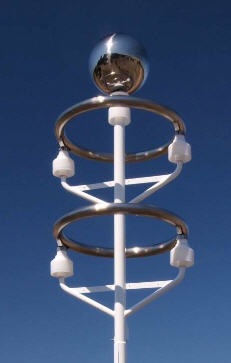
In a recent paper published by the Royal Meteorological Society*, 33% of all lightning incidents occur at sports and recreation grounds and parks, with 27% of these being fatal. With our weather patterns changing, severe weather events including destructive and dangerous thunderstorms are expected to become more frequent.
Large sporting events and leisure activities that attract large numbers of people are at risk from lightning, but a new thunderstorm detector from Biral can provide early warning of these lightning strikes. This new system will be ideal where there are cricket, football and rugby matches, athletics events, golfing tournaments or large outside concerts. A direct lightning strike at these events, with high concentrations of people, would pose a serious threat to life with multiple casualties.
Biral’s experience from the aviation and industrial sectors where the dangers of lightning activity have been understood for many years, has allowed the company to develop its new BTD-300 Thunderstorm Detector for many different applications.
Whilst there are existing lightning systems available, these only alert after the strikes have begun, whereas Biral’s new BTD-300 uses a quasi-electrostatic operating principle which gives early warnings of overhead lightning risk and detects strikes as far as 83 km away.
Biral is one of the world leaders in meteorological instrumentation and its BTD-300 Thunderstorm Detector is a standalone sensor that reliably detects the presence of all forms of lightning. The detector has a very low false alarm rate and the ability to warn of the risk of overhead lightning.
The basic sensor detects and ranges both cloud-to-cloud and cloud-to-ground lightning. The ability to reliably detect and range cloud-to-cloud lightning, which is typically much more common than cloud- to-ground strikes, makes the BTD-300 much more sensitive to the presence of storms compared to devices that rely solely upon detecting radio emissions from the lightning. As cloud-to-cloud lightning often precedes cloud-to-ground strikes, the sensor can give the user earlier warnings of lightning risk.
The quasi-electrostatic operating principle allows the sensor to detect charged precipitation and the presence of strong electric fields, both of which are indicators of lightning risk. In this way the BTD-300 can warn of the risk of overhead lightning before the first lightning strike occurs.
By monitoring the slow-varying electrostatic field rather than relying on radio wave detection the BTD-300 is almost immune to electromagnetic interference which is the major cause of false alarms for radio based detectors. It is thus the ideal choice for high radio emission environments, for example where there are communication antennas, heavy machinery and plant or near to large industrial factories.
Virtually maintenance free in operation, the BTD 300 can either interface directly to an integrated system or be operated using the supplied display and logging software. The optional warning relay module allows the sensor to automatically sound alarms whenever a storm approaches.
*Royal Meteorological Society, 221 Weather – August 2014, Vol. 69, No. 8, “Deaths and injuries from lightning in the UK, 1988–2012” by Derek M. Elsom and Jonathan D. C. Webb.
Biral www.biral.com

